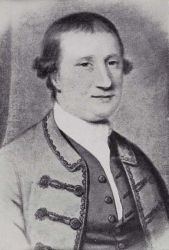Sir John Wedderburn, 5th Baronet of Blackness facts for kids
Quick facts for kids
Sir John Wedderburn
|
|
|---|---|
 |
|
| Born | |
| Died | 28 November 1746 Kennington Common, London
|
| Nationality | Scottish |
| Occupation | landowner |
| Known for | The "Forty Five" |
Sir John Wedderburn, 5th Baronet of Blackness, was a Scottish landowner from Perthshire. He joined the Jacobite rebellion of 1745, which was an attempt to put Charles Edward Stuart (also known as Bonnie Prince Charlie) back on the throne of Great Britain.
After the rebellion, Sir John was captured at the Battle of Culloden. He was taken to London and found guilty of treason, which means betraying one's country. He was executed, and his family lost their land and titles for a time. The "Blackness" in his title refers to Blackness House in Dundee, not the town of Blackness near Edinburgh. His son, John Wedderburn of Ballindean, later moved to Jamaica. There, he rebuilt the family's wealth through sugar plantations and eventually got his father's title back.
Early Life and Family
John Wedderburn was the son of Alexander Wedderburn, the 4th Baronet. His father had lost his job in Dundee in 1717 because he supported the Stuarts in an earlier rebellion in 1715. This was the Jacobite rising of 1715, which supported the "Old Pretender," James Francis Edward Stuart.
John had a sister named Elizabeth. She married Alexander Read in 1715. Their daughter, Catherine Read, became a well-known portrait painter.
Sir John Wedderburn did not receive the inheritance he expected. This led to difficult times for him and his family. He lived on a small farm with a simple house. He worked very hard to support his nine children, who often ran around barefoot.
The 1745 Jacobite Rebellion
In 1745, Sir John Wedderburn joined the rebellion led by Charles Edward Stuart. This rebellion aimed to overthrow the Hanoverian royal family who were then ruling Britain. Sir John served as a colonel in the Jacobite army.
He was captured at the Battle of Culloden, which was the final battle of the rebellion. After his capture, he was sent to London for trial. On November 4, 1746, he was accused of treason. Even though he argued that he had not personally fought against the Crown, he was found guilty. Sir John Wedderburn was executed at Kennington Common on November 28, 1746.
Sir John's Children and Their Lives
Sir John Wedderburn married Jean Fullerton in 1724. She lived until 1766. They had two sons, John and James, and also daughters. After Sir John's execution, his daughters were cared for by their cousin, the portrait painter Catherine Read.
- John Wedderburn of Ballendean (1729–1803) was Sir John's oldest son. After the 1745 rebellion failed, he went to London. He tried to get his father pardoned, but he was unsuccessful. He even had to witness his father's execution. John then returned to Scotland, but he saw few opportunities there. He decided to start a new life in the Caribbean. He worked his way to Jamaica on a ship. For many years, he worked as a planter, becoming wealthy from sugar produced by enslaved people. He later returned to Scotland. He brought an enslaved man named Joseph Knight with him. Joseph Knight later took him to court in a freedom suit, which was a legal case to gain freedom. This case set an important example in Scots law. John Wedderburn eventually regained his family's social standing. His daughter, Louisa, married General John Hope, 4th Earl of Hopetoun.
- James Wedderburn was Sir John's second son. He also went to Jamaica. There, he had a son named Robert Wedderburn with one of his slaves. Robert was not accepted by his father's family. He later wrote a book called The Horrors of Slavery, which was used by the abolitionist movement to fight against slavery. A descendant of Robert was Bill Wedderburn, Baron Wedderburn of Charlton (1927-2012), a famous legal scholar. James also had children with his wife, Mary Louisa Eden. These included Andrew Colvile, who became a governor of the Hudson's Bay Company, and Jean, who married Thomas Douglas, 5th Earl of Selkirk. Another son, James Wedderburn, became the Solicitor General for Scotland.

